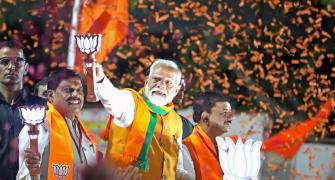There were compelling reasons to send Juan Valdez off to the old folks home for advertising's ex-celebs. The fictional coffee-growing icon had been featured in ads for decades, helping establish "100 per cent Colombian coffee" as a global brand. But Juan wasn't aging well. Recent TV spots showed him surfing with his faithful mule, Conchita, and popping up in kitchen pantries. While humorous, the ads reinforced the notion that Juan had become a bit of a joke.
Yet at the eleventh hour, the National Federation of Coffee Growers of Colombia decided that introducing a new, younger "Juan in a million" would be better than retiring him. A brand consultancy in Portland, Oregon, called Character advised that Juan's appeal--humble but uncompromising, dedicated to the hard work of raising coffee by hand--could still be valuable.
"Juan Valdez taps into a fundamental human truth," contends Jim Hardison, Character's creative director, "that the things we savor the most are the hardest earned." People emotionally connect with Juan because he seems authentic, Hardison reminded the federation, and authenticity is a priceless commodity.
In an increasingly shiny, fabricated world of spun messages and concocted experiences--where nearly everything we encounter is created for consumption--elevating a brand above the fray requires an uncommon mix of creativity and discipline. And nowhere do you see the challenge more starkly illustrated than in the quest for authenticity.
How companies fake authenticity
"Authenticity is the benchmark against which all brands are now judged," notes John Grant in The New Marketing Manifesto. Or as Seth Godin quips in Permission Marketing: "If you can fake authenticity, the rest will take care of itself."
Overloaded by sales pitches, consumers are gravitating toward brands that they sense are true and genuine. Hunger for the authentic is all around us. You can see it in the way millions are drawn to mission-driven products like organic foods. It's there in the sex-without-guilt way people respond to the footloose joy of BMW's Mini. You see it in the tribes of "i-centered" buyers who value individuality and independence--and whom Apple has so cleverly cultivated through its iMacs and iPods.
Yet our sense of what's "real" in this post-postmodern world takes on all kinds of strangely distorted shapes and guises, as if it's reflected back at us from a swirl of fun-house mirrors. A fictional coffee grower, it turns out, has lasting resonance. The Daily Show With Jon Stewart, with its hoaxy newscasts, comes across as authentic in large part because it self-consciously declares itself to be fake.
A coffeehouse chain like Starbucks can rise to prominence by creating an imitation of Milan's espresso bars--and then be pilloried (by its own chairman, among others) for not staying true to that fabricated experience. What's authentic is not always real, and what's real is not always what it seems.
Playing the authenticity game in a sophisticated way has become a requirement for every marketer, because the opposite of real isn't fake--it's cynicism. When a brand asserts authenticity in a clumsy way, it quickly breeds distrust or, at the very least, disinterest.
Just remember Coca-Cola's attempt to muck with the Real Thing's original formula--and the calamitous launch of New Coke. Or consider the plight of Levi's, at one time the very epitome of an authentic American brand, which became increasingly out-of-date to new lovers of denim.
Both the promise and the peril of "getting real" are, indeed, very real. "Authentic" is derived from the Greek authentikós, which means "original." And unfortunately, there's no recipe for originality. Each brand must build its own primary source code for the authentic.
Still, there are some larger lessons (and pitfalls) that anyone charged with overseeing a brand would be wise to consider. What follows is a series of questions that every brand, at some point in its evolution, will have to wrestle with if it hopes to be, in the immortal words of Smokey Robinson, "really, really real."
What does it take to be authentic?
Authenticity constantly requires reinforcement, and it can come from a number of sources: craftsmanship, timeliness, relevance. But it is a brand's values--the emotional connection it makes--that truly define its realism. And there are four primary strands that draw out that connection.
A sense of place. "Authenticity comes from a place we can connect with," says Steve McCallion, creative director of Ziba, a Portland, Oregon--based design consultancy. "A place with a story." The Champagne region of France, for instance, helps give Veuve Clicquot special cachet.
And yet, our notion of place does not need to be literal. On the contrary, it can sometimes prove considerably elastic. Häagen-Dazs, the Nordic-sounding ice cream, originated in that quaint Scandinavian village known as the Bronx, New York. The brand's name, concocted from two nonsensical words, is a perfect fake--so well chosen, and so evocative, that it resonates as real to folks who love the product.
A strong point of view. Authenticity also emerges from "people with a deep passion for what they are doing," says McCallion. So Martha Stewart is perceived to be authentic in large part because her ambitious recipes for Perfect White Cake and Chocolate-Strawberry Heart-Shaped Ice-Cream Sandwiches stand in the face of a world where food is mass-produced and preparation for the average dinner is measured by the number of minutes it takes to microwave the thing.
Serving a larger purpose. Consumers quite rightly believe, until they're shown otherwise, that every brand is governed by an ulterior motive: to sell something. But if a brand can convincingly argue that its profit-making is only a by-product of a larger purpose, authenticity sets in. "Just as there are purpose-driven lives," says Character's Hardison, "there are purpose-driven brands." (Think Whole Foods) here, or even, in a way, Google. The counterpart is also true: "When a brand changes its story to better capture its customers' dollars, it's basically a poser," Hardison says, "and people sense that right away."
Integrity. Authenticity comes to a brand that is what it says it is. In other words, "the story that the brand tells through its actions aligns with the story it tells through its communications," Hardison says. "Only then will customers sense that the brand's story is true."
When McDonald's launched its "We love to see you smile" campaign in 2000, commentators like Advertising Age's Bob Garfield hooted in derision, arguing that filthy restrooms and grumpy counter clerks rendered the ads "preposterously false."
A year later, published reports revealed that rude employees were costing Mickey D's millions of dollars in lost sales. And when bloggers exposed a flog (read: "fake blog") that masqueraded as a travel journal written by a couple who were compensated for their gushing posts about Wal-Mart, the deception elicited a torrent of rebuke.
How do you stay authentic even as you get big?
Imagine you lived in Atlanta, and one day in the mid-1990s, you came across a tiny sandwich café tucked into Sandy Springs, a nearby suburb. Seduced by the eatery's yeasty charms, you fell for its French baguettes and Italian pesto focaccia, freshly baked every morning, right on site. The Atlanta Bread Co, as it was called, became your discovery--your place--and you began stopping there at least once a week.
But some time later, on a business trip to Detroit, you were walking across Pointe Plaza, when suddenly, there it was--an almost exact duplicate of your café. Atlanta Bread had been franchised (it currently counts 150 locations in 27 states), and while the baguettes were as fresh as ever, the experience of shopping there just wasn't the same. A replica Atlanta Bread somehow felt a little less special than the original.
Ubiquity might not be toxic to authenticity, but it certainly dilutes it. When a brand spreads far beyond its home turf, its branches almost invariably (though not inevitably) weaken. Ben & Jerry's ice cream and Tom's of Maine toothpaste lose a bit of their authentic luster when they're snapped up by the likes of Unilever and Colgate-Palmolive -- global behemoths trying to act local.
No business has confronted this challenge more urgently than Starbucks. As chairman Howard Schultz lamented to upper management in a bluntly worded missive on Valentine's Day, the company's rapid growth has "led to the watering down of the Starbucks experience," and the company's stores "no longer have the soul of the past."
The Seattle-based coffee juggernaut gained its authentic mien as the quintessential "third place" (after home and the workplace), where people could linger for hours over "grandes" of java. Yet today, stores are overrun with a clutter of CDs, coffeemakers, puzzles, bagged beans, and more. The outposts have become as much retail space as meeting place.
"It will be another decade before Starbucks becomes as meaningless as Chock Full o'Nuts," jokes Patrick Hanlon, CEO of the brand consultancy Thinktopia. Despite Schultz's impassioned outburst, Starbucks has not retreated from its previously stated aim to eventually establish 40,000 retail outlets around the world. "As it lurches slowly toward ubiquity," Hanlon notes, "it moves further and further away from authenticity."
Yet it doesn't have to be that way for all big brands. Another colossus from the Pacific Northwest, Nike, has demonstrated that growth and authenticity are not wholly incompatible. A framed black-and-white photograph that hangs in CEO Mark Parker's corner office in Beaverton, Oregon, reveals one of the secrets to how Nike keeps it real even as it has grown to more than 28,000 employees and a portfolio of 13,000 products.
The portrait is of Bill Bowerman, the legendary University of Oregon track coach and Nike cofounder, who died in 1999. "If you talk to a lot of designers around here, they'll say they've got Bill sitting on their shoulder, speaking up for the athlete," Parker says.
By taking "deep dives" into various sports tribes and using the resulting insights to become more relevant--and therefore more authentic--Nike has maintained a renegade edge. As Parker tells it, not so long ago the company believed it was "too big, too corporate" to be accepted by the skateboarding culture.
But as the market grew to 15 million skaters who generate $3 billion in annual sales, Nike plunged in. Parker assembled a Nike Skateboarding team that lived and breathed skate. It worked with hard-core skaters to develop a shoe, dubbed the Dunk, customized for skateboarding.
It signed hot young skaters to represent the new Nike SB division. And it brought in maverick graphic artists to tell their stories on the canvas of Dunk shoes. To some die-hard skaters, Nike may still be a wannabe, but it has managed to pick off a sizable chunk of customers. The antidote to size and ubiquity--for Nike, at least--has been to go vertical. "As we get bigger," Parker says, "we get deeper."
Can you be authentic when you're trying to be authentic?
The first time you hear a quartet of Cold Stone Creamery's ice-cream slingers, in response to a tip, warble a verse of "Sprinkle, sprinkle candy bar, this is what our mix-ins are," it feels both silly and endearing. But when the same bit of showmanship is replayed on repeat visits, it comes off as shtick.
It turns out that Cold Stone, the No. 3 ice-cream chain in the United States with more than 1,300 stores, auditions prospective scoopers to see who can carry a tune that will amuse the kids and ultimately move more mint chocolate. Although dishing up a little dazzle with its sundaes might help Cold Stone achieve its goal of toppling Dairy Queen and becoming the nation's big cherry by 2010, mandated singing feels phony.
The crooning Cold Stoners share the same plight as Wal-Mart's smiley greeters. Coerced by corporate fiat, their "warmth" can wear out its welcome and feel contrived. That's one reason why we so often distrust the big-box retailers and chain stores: Their take on what's authentic springs straight from the company manual. Authenticity is necessary, but it cannot be compelled.
And therein lies an authentic paradox: A brand doesn't feel real when it overtly tries to make itself real. To the hypertargeted consumer, baldly billboarding a brand's message smacks of insincerity. General Motors' "Our Country, Our Truck" campaign for Chevrolet's Silverado offers a striking example. Silverado's TV commercials, which this past fall were in heavy rotation on NFL games, featured clichéd images of he-man Americana--rugged factory workers, proud firefighters, and the truck itself, lumbering through a golden field of grain--backed by John Mellencamp's song "Our Country," an ode to America's can-do spirit. Media critics assailed the ads, in part because the original spots flashed iconic images of Martin Luther King Jr. and Rosa Parks, all in the service of selling trucks.
But GM also has trouble walking the talk of Silverado's gauzy message. We know that, while GM is celebrating the workin' man, its recent history includes layoffs that have put tens of thousands on the street. And, as Slate has pointed out, we know that while Mellencamp indulges in a bit of jingoism with his declaration that "this is our country," he once sang a remarkably similar line, "ain't that America," with a caustic edge. "Our Country, Our Truck" has all of the trappings but none of the rich truths that make for a truly authentic story.
Can you be cool and still be authentic?
Chris Bangle, BMW's design director, contends there's a universal explanation for why successful brands stumble: They fail to evolve. Bangle calls them "fortress brands." Deeply rooted in their heritage and values, they are inflexible, unmovable, and ultimately stuck in time. "That's the problem with a dogmatic, static brand," he says. "The competition will outflank it, and the world will pass it by."
Levi's, for one, is a brand that appears to have slipped into the fortress category. The king of denim, whose founder stitched and riveted the world's first pair of jeans in 1873, has lately missed out on the fast-changing trends of an industry that it created.
When the craze for $200-a-pair, ripped and jewel-studded denim exploded in the late 1990s, Levi's persisted in distributing boxy jeans for men through cut-rate retailers. According to a January report in The New York Times, Levi's is now the apparel industry's most litigious company--a sure sign of a reactionary brand that attacks by retreating.
To maintain its integrity, a brand must remain true to its values. And yet, to be relevant--or cool--a brand must be as dynamic as change itself. An authentic brand reconciles those two conflicting impulses, finding ways to be original within the context of its history.
Look at Abercrombie & Fitch. Its flagship store on New York's Fifth Avenue twines the company's legacy as a purveyor of outdoor paraphernalia with its role as modern-day hangout for teens buying jeans and T-shirts. The store combines the visual iconography of its origins--a moosehead mounted over the cashier's counter, wooden canoes, and racks of ancient shotguns--with the dark lighting and amped-to-the-max soundtrack of an after-hours dance club.
"This place mixes the old and new in a really delightful way," Thinktopia's Hanlon shouted above the din, when we visited on a recent Monday afternoon. "It's an inspiration that proudly declares you can have more than 900 stores scattered in shopping malls throughout the US and still have soul."
Sometimes even the most homogenized of places can evoke a flicker of authenticity. The morning after last fall's congressional elections, the newly elected senator from New Jersey, Robert Menendez, breakfasted at his usual spot, the International House of Pancakes in Union City. Menendez, formerly mayor of Union City, sat in his regular booth, ordered the same breakfast he always orders, and spent an hour catching up with longtime friends.
Few restaurants are more prefab than IHOP, yet there Menendez was, paying homage to a staff that knew his breakfast by heart and to patrons who've watched his kids grow up. On the surface, the Union City franchise is hardly authentic--it's similar to the IHOP in, say, Muncie, Indiana. But the friendships that Menendez has made there are certainly genuine.
It's not that Starbucks, Cold Stone Creamery, BMW, Nike, or any other brand is really, really real. What's real are the experiences and the connections that the brands allow us to make--if they give us an honest chance.







